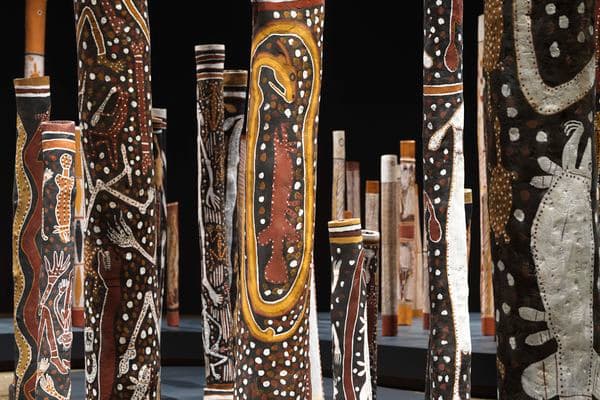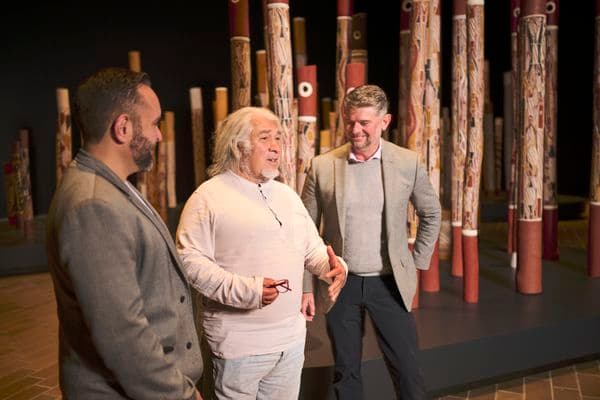Rembarrnga people

Victor Pamkal, Rembarrnga people, Two bands of designs against rarrk, 1987–88, purchased with the assistance of funds from National Gallery admission charges and commissioned in 1987
Key information
Rembarrnga clan country lies to the south and west of Ramingining, towards the Katherine area. It is the inland stone country, marked by rocky outcrops and sweeping plains as the landscape gives way to the sandstone escarpment country of west Arnhem Land. The rugged nature of this environment is reflected in the materials used and the execution of the hollow logs from this region.
Cross-hatching is largely dispensed with in favour of bold, painterly white on black. The creatures depicted abound in the landscape — goannas, tortoises, snakes, yabbies, barramundi, frogs, snakes, spiders and yams. Their internal organs are made visible, a practice of artists further to the west.
Paddy Fordham Wainburranga's almost menacing imagery is concerned with the epic encounters of ancestors by which the features of the landscape were created, particularly Rainbow Serpents in various guises, and spirit figures.
Themes of regurgitation, metamorphosis and renewal are prevalent in these poles.
The path through the Memorial imitates the course of the Glyde River estuary which flows through the Arafura Swamp to the sea. The hollow log coffins are situated broadly according to where the artists' clans live along the river and its tributaries.

David Blanasi, Rembarrnga people, Fish, yam bones in three bands, 1987–88, purchased with the assistance of funds from National Gallery admission charges and commissioned in 1987

Victor Pamkal, Rembarrnga people, Two bands of designs against rarrk, 1987–88, purchased with the assistance of funds from National Gallery admission charges and commissioned in 1987

Joe Patrick Birriwanga, Rembarrnga people, Goannas and snakes, 1987–88, purchased with the assistance of funds from National Gallery admission charges and commissioned in 1987

David Blanasi, Rembarrnga people, Plants, fish and body designs in four bands, 1987–88, purchased with the assistance of funds from National Gallery admission charges and commissioned in 1987

Joe Patrick Birriwanga, Rembarrnga people, Tortoise, frogs and snakes, 1987–88, purchased with the assistance of funds from National Gallery admission charges and commissioned in 1987

Joe Patrick Birriwanga, Rembarrnga people, Snakes, fish, frogs, goannas, flowers and tortoise against rarrk, 1987–88, purchased with the assistance of funds from National Gallery admission charges and commissioned in 1987
Clan stories
Rainbow Serpent — Metamorphosis — Spirit Figures
Artist Paddy Fordham Wainburranga depicts the great upheavals which led to the creation of the Rembarrnga lands in ancestral times; Rainbow Serpents swallow spirit figures, which are regurgitated as features of the landscape. Many of the spirit figures are known as Balangjarngalain. Unlike Mimi spirits, who live in rocks, the Balangjarngalain live in the low tree plains country or 'station country' of the south-western and south-central areas of Arnhem Land.
Rembarrnga people relate a belief that Balangjarngalain take babies when no-one is looking, as a warning to people to take good care of their children. Believed to be half human and half spirit, the Balangjarngalain are thought to disappear into the human or spirit worlds at will. Their main role is to see that human beings behave according to the spirits' wishes. They also taught the Rembarrnga people how to hunt and to cook food.
Rembarrnga country incorporates vast grassy plains and stony, rocky regions. Due to the country's relative isolation and inaccesibility, Rembarrnga art has developed traditions and styles quite separate from each other and quite distinct from other groups in Central Arnhem Land. The artists within the group share common themes of water, stone country and spirit figures. Paddy Fordham Wainburranga says he paints 'old way' having learnt to paint from his father. He and other Rembarrnga artists dispense with cross-hatching (rarrk) in favour of multiple dots, which help describe the country while emanating hypnotic power equal to the rarrk of other groups.











